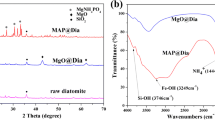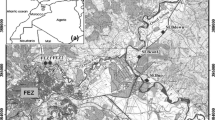Abstract
The dispersion of mine tailings affects ecosystems due to their high content of potentially toxic elements. Environmental risk increases when the soil impacted by tailings is used for agriculture; this use may result in health impacts. This study analyzes the feasibility of remediating a calcareous soil (used for maize cultivation) polluted with lead in the semiarid zone of Zimapán, México, by using EDTA as an extractant. Total geoavailable and bioaccessible concentrations in the gastric and intestinal phases were determined to evaluate lead availability and health risk. The soil was then washed with EDTA, and the geochemical fractionation (interchangeable, carbonates, Fe/Mn oxy-hydroxides, organic matter–sulfides, and residual) and impact on the mesophile bacteria and fungi/yeast populations were analyzed. The results showed total Pb concentrations up to 647 ± 3.50 mg/kg, a 46% bioaccessible fraction (297 ± 9.90 mg/kg) in the gastric phase and a 12.2% (80 ± 5 mg/kg) bioaccessible fraction in the intestinal phase, indicating a health and environmental risk. Meanwhile, the geochemical fractionation before washing showed a Pb fraction mainly consisting of Fe/Mn oxy-hydroxides (69.6%); this reducible fraction may progressively increase its bioaccessibility. Geochemical fractionation performed in the washed soil showed differences from that determined before the treatment; however, the iron and manganese fraction, at 42.4%, accounted for most of the Pb. The soil microbiology was also modified by EDTA, with an increase in aerobic bacteria and a decrease in fungi/yeast populations. Although 44% total lead removal was achieved, corresponding to a final concentration of 363.50 ± 43.50 mg/kg (below national and USEPA standards), washing with EDTA increased the soluble and interchangeable lead concentrations. Statistical analysis indicated a significant effect (p < 0.05) of EDTA on the soil’s geochemical fractionation of lead.







Similar content being viewed by others
References
Amrate, S., Akretche, D. E., Innocent, C., & Seta, P. (2005). Removal of Pb from a calcareous soil during EDTA-enhanced electrkinetic extraction. Science of the Total Environment, 349, 56–66.
Armienta, M. A., Mugica, V., Reséndiz, I., & Gutierrez, A. M. (2016). Arsenic and metals mobility in soils Impacted by tailings at Zimapán Mexico. Journal of Soils and Sediments, 16(4), 1267–1278.
Armienta, M. A., Beltrán, M., Martínez, S., & Labastida, I. (2019). Heavy metal assimilation in maize (Zea mays L.) plants growing near mine tailings. Environmental Geochemistry and Health, 42, 2361–2375.
Barona, A., Aranguiz, I., & Elías, A. (2001). Metal associations in soils before and after EDTA extractive decontamination: Implications for the effectiveness of further clean-up procedures. Environmental Pollution, 113, 79–85.
Blowes, D. W., Ptacek, C. J., Jambor, J. L., & Weisener, C. G. (2005). The geochemistry of acid mine drainage. In B. S. Lollar, H. D. Holland, & K. K. Turekian (Eds.), Environmental geochemistry vol. 9 treatise on geochemistry (pp. 149–195). Oxford: Elsevier-Pergamon.
Bolan, N., Kunhikrishnan, A., Thangarajan, R., Kumpiene, J., Park, J., Makino, T., et al. (2014). Remediation of heavy metal(loid)s contaminated soils—To mobilize or to immobilize? Journal of Hazardous Materials, 266, 141–166.
Castañeda, M. T. (2009). MicrobiologíaAplicada (p. 240). México: Manual de laboratorio de microbiología. Universidad AutónomaMetropolitana. D. F.
Castro-Larragoitia, J., Kramar, U., Monroy-Fernández, M. G., Viera-Décida, F., & García-González, E. G. (2013). Heavy metal and arsenic dispersion in a copper-skarn mining district in a Mexican semi-arid environment: sources, pathways, and fate. Environmental Earth Sciences, 69, 1915–1929.
Di Palma, L., Ferrantelli, P., Merli, C., Petrucci, E., & Pitzolu, I. (2007). Influence of soil organic matter on copper extraction from contaminated soil. Soil and Sediment Contamination: An International Journal, 16(3), 323–335.
Duarte, Z. V. M., Carrillo-González, R., Lozano, M. L., & Carrasco, V. (2019). Fractionation of heavy metals in mine tailings amended with compost manure. Soil and Sediment Contamination: An International Journal, 28(2), 148–161.
Gabos, M. B., Abreu, C. A., & Coscione, A. R. (2009). EDTA assisted phytorremediation of a Pb contaminated soil: Metal leaching and uptake by black beans. Scientia Agricola, 66(4), 506–514.
García-Meza, J. V. (2008). Autotrophic biofilm development on superficial samples of the gold-silver mine tailings, Valenciana (Mexico): Pioneers in tailings remediation? Bulletin on Environmental Contamination and Toxicology, 80(1), 53–57.
Hill, W., & Evans, D. (1965). Solubility of twenty minerals in selected versene (EDTA) solutions. Resource document. Kansas Geological Survey.
https://www.kgs.ku.edu/Publications/Bulletins/175_3/index.html. Retrieved Mar, 6 2020.
INEGI, Instituto Nacional de Estadística y Geografía (2020) Resource document.
https://www3.inegi.org.mx/contenidos/app/mexicocifras/datos_geograficos/13/13084.pdf Retrieved Mar, 6 2020.
https://www.inegi.org.mx/default.html Retrieved Mar 6, 2020.
Juhasz, A. L., Weber, J., & Smith, E. (2011). Impact of soil particle size and bioaccessibility on children and adult lead-exposure in peri-urban contaminated soils. Journal of Hazardous Materials, 186, 1870–1879.
Kabata-Pendias, A. (2011). Trace elements in soils and plants (Fouth, p. 505). Boca Raton, USA: CRC Press.
Kim, C. (1996). Extraction of lead using EDTA: Factors affecting extraction, effects of amorphous iron and recycling of used EDTA. PHD dissertation, UMI, 105.
Labastida, L., Armienta, M. A., Lara, R. H., Briones, R., González, I., & Romero, F. (2019). Kinetic approach for the appropriate selection of indigenous limestones for acid mine drainage treatment with passive systems. Science of the Total Environment, 677, 404–417.
Lara, R. H., Briones, R., Monroy, M. G., Mullet, M., Humbert, B., Dossot, M., et al. (2011). Galena weathering under simulated calcareous conditions. Science of the Total Environment, 409, 3971–3979.
Lin, Z., Comet, B., Qvarfort, U., & Herbert, R. (1995). The chemical and mineralogical behavior of Pb shooting range soils from Central Sweden. Environmental Pollution, 89(3), 303–309.
Mahvi, A. H., Mesdaghinia, A. R., & Naghipoor, D. (2005). Comparison of heavy metals extraction efficiency in contaminated soils by various concentrations of EDTA. Pakistan Journal of Biological Sciences, 8(8), 1081–1085.
Mahmood-ul-Hassan, M., Suthar, V., Ahmad, R., & Yousra, M. (2017). Heavy metal phytoextraction—natural and EDTA-assisted remediation of contaminated calcareous soils by sorghum and oat. Environmental monitoring and assessment, 189, 591.
Méndez, M., & Armienta, M. A. (2003). Arsenic phase distribution in Zimapán mine tailings Mexico. RevistaInternacional de ContaminaciónAmbiental, 42(1), 131–140.
Moreno, R., Téllez, J., & Monroy, M. (2012). Influencia de los minerales de los jales en la bioaccesibilidad de arsénico, plomo, zinc y cadmio en el distritomineroZimapán México. RevistaInternacional de ContaminaciónAmbiental, 28(3), 203–218.
Niinae, M., Nishigaki, K., & Aoki, K. (2008). Removal of lead from contaminated soils with chelating agents. Materials Transactions, 49(10), 2377–2382.
Oviedo, C., & Rodríguez, J. (2003). EDTA: the chelating agent under environmental scrutiny. Quimica Nova, 26(6), 901–905.
Rangaswami, G., & Bagyaraj, D. (2005). Agricultural microbiology. New Delhi: Prentice-Hall of India.
Sariñana-Ruiz, Y. A., Vazquez-Arenas, J., Sosa-Rodriguez, F. S., Labastida, I., Armienta, M. A., Aragón-Piña, A., et al. (2017). Assessment of arsenic and fluorine in surface soil to determine environmental and health risks factors in the Comarca Lagunera, Mexico. Chemosphere, 178, 391–401.
SEMARNAT, Secretaría del Medio Ambiente y Recursos Naturales, (2000). NOM-021-SEMARNAT-2000. Norma Oficial Mexicana que establece las especificaciones de fertilidad, salinidad y clasificación de suelos, estudio y análisis. Diario Oficial de la Federación.
SEMARNAT, Secretaría del Medio Ambiente y Recursos Naturales, (2004). NOM-147-SEMARNAT/SSA1–2004. Norma Oficial Mexicana que establece criterios para determiner las concentraciones de remediación de suelos contaminados por arsénico, bario, berilio, cadmio, cromo hexvalente, mercurio, níquel, plata, plomo, selenio, talio y/o vanadio. México: Diario Oficial de la Federación.
SEMARNAT, Secretaría del Medio Ambiente y Recursos Naturales, (2009). NOM-157-SEMARNAT-2009. Norma Oficial Mexicana que establece los elementos y procedimientos que se deben considerar al formular y aplicar los planes de manejo de residuos mineros, con el propósito de promover la prevención de la generación y la valorización de los residuos, así como alentar su manejo integral a través de nuevos procesos, métodos y tecnologías que sean económica, técnica y ambientalmente factibles. México: Diario Oficial de la Federación.
SSA, Secretaría de Salud, (1994) MODIFICACION a la Norma Oficial Mexicana NOM-127-SSA1–1994, Salud ambiental. Agua para uso y consumo humano. Límites permisibles de calidad y tratamientos a que debe someterse el agua para su potabilización. México: Diario Oficial de la Federación.
Sun, B., Zhao, F. L., Lombi, E., & McGrath, S. P. (2001). Leaching of heavy metals from contaminated soils using EDTA. Environmental Pollution, 113(2), 111–120.
Suthar, V., Memon, K. S., & Mahmood-ul-Hassan, M. (2014). EDTA-enhanced phytoremediation of contaminated calcareous soils: Heavy metal bioavailability, extractability, and uptake by maize and sesbania. Enviromental Monitoring and Assessment, 186, 3957–3968.
Stumm, W., & Morgan, J. J. (1996). Aquatic chemistry (3rd edn.). New York: Wiley, 1022 p.
Tessier, A., Campbell, P. G. C., & Bisson, M. (1979). Sequential extraction procedure for the speciation of particulate trace metals. Analytical Chemistry, 51(7), 844–851.
Torres, L. G., Lopez, R. B., & Beltran, M. (2012). Removal of As, Cd, Cu, Ni, Pb, and Zn from a highly contaminated industrial soil using surfactant enhanced soil washing. Physics and Chemistry of the Earth, Parts A/B/C, 37–39, 30–36.
Udovic, M., & Lestan, D. (2012). EDTA and HCL leching of calcareous and acidic soils polluted with potentially toxic metals: Remediation effeciency and soil impact. Chemosphere, 88, 718–724.
USEPA, United States Environmental Protection Agency (2001). Residential lead hazard standards-TSCA section 403. Office of pollution prevention and toxics. Environmental Protection Agency, US.
USEPA, United States Environmental Protection Agency (2003). Test methods. SW-846 7000A Index to EPA Test methods, april 2003 revised version.US.
USEPA, United States Environmental Protection Agency (2007). Method 3051A. microwave assisted acid digestion of sediments, sludges, soils and oils, US.
Acknowledgements
We acknowledge Alejandra Aguayo and Olivia Cruz for collaborating in the chemical determinations. We are indebted to two anonymous reviewers for their important observations and suggestions.
Author information
Authors and Affiliations
Corresponding author
Additional information
Publisher's Note
Springer Nature remains neutral with regard to jurisdictional claims in published maps and institutional affiliations.
Rights and permissions
About this article
Cite this article
Labastida, I., Mercado, L.A., Rojas, S. et al. Remediation by means of EDTA of an agricultural calcareous soil polluted with Pb. Environ Geochem Health 43, 2231–2242 (2021). https://doi.org/10.1007/s10653-020-00754-5
Received:
Accepted:
Published:
Issue Date:
DOI: https://doi.org/10.1007/s10653-020-00754-5




